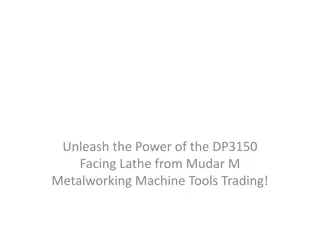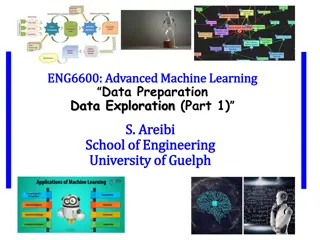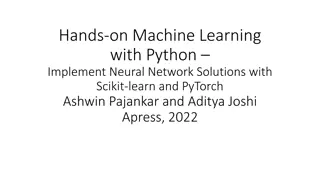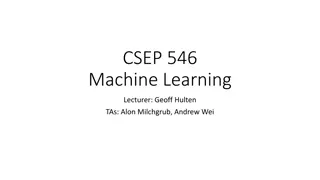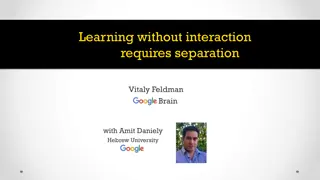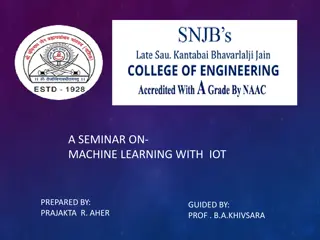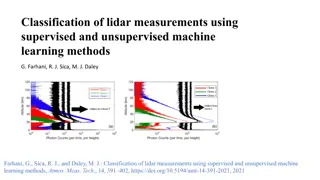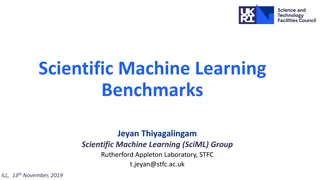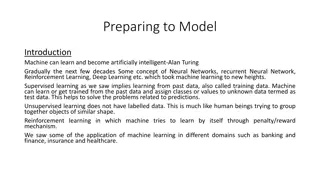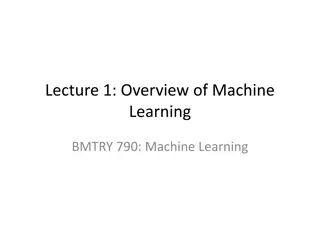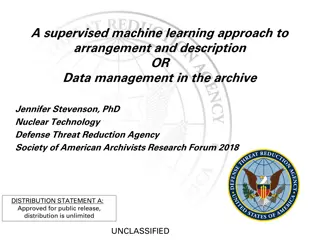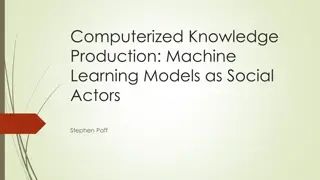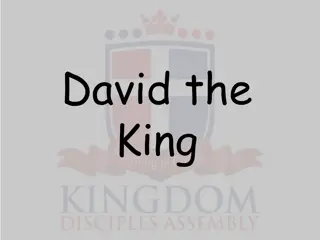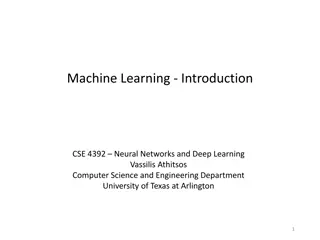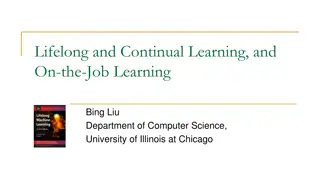Machine Learning Basics with David Kauchak
Dive into the world of machine learning with David Kauchak in CS159 Spring 2019. Explore the construction and study of systems that can learn from data, optimize performance criteria, and predict future outcomes. Discover why machine learning is essential in today's data-driven world and the importance of domain knowledge and expertise.
Download Presentation

Please find below an Image/Link to download the presentation.
The content on the website is provided AS IS for your information and personal use only. It may not be sold, licensed, or shared on other websites without obtaining consent from the author.If you encounter any issues during the download, it is possible that the publisher has removed the file from their server.
You are allowed to download the files provided on this website for personal or commercial use, subject to the condition that they are used lawfully. All files are the property of their respective owners.
The content on the website is provided AS IS for your information and personal use only. It may not be sold, licensed, or shared on other websites without obtaining consent from the author.
E N D
Presentation Transcript
MACHINE LEARNING BASICS David Kauchak CS159 Spring 2019
Admin Assignment 6a How d it go? Which option/extension are you picking? Quiz #3 next Monday No hours today
Machine Learning is Machine learning, a branch of artificial intelligence, concerns the construction and study of systems that can learn from data.
Machine Learning is Machine learning is programming computers to optimize a performance criterion using example data or past experience. -- Ethem Alpaydin The goal of machine learning is to develop methods that can automatically detect patterns in data, and then to use the uncovered patterns to predict future data or other outcomes of interest. -- Kevin P. Murphy The field of pattern recognition is concerned with the automatic discovery of regularities in data through the use of computer algorithms and with the use of these regularities to take actions. -- Christopher M. Bishop
Machine Learning is Machine learning is about predicting the future based on the past. -- Hal Daume III
Machine Learning is Machine learning is about predicting the future based on the past. -- Hal Daume III past future Training Data Testing Data model/ predictor model/ predictor
Why machine learning? Lot s of data Hand-written rules just don t do it Performance is much better than what people can do Why not just study machine learning? Domain knowledge/expertise is still very important What types of features to use What models are important
Why machine learning? Be able to laugh at these signs
Machine learning problems What high-level machine learning problems have you seen or heard of before?
Data examples Data
Data examples Data
Data examples Data
Data examples Data
Supervised learning examples label label1 label3 labeled examples label4 label5 Supervised learning: given labeled examples
Supervised learning label label1 model/ predictor label3 label4 label5 Supervised learning: given labeled examples
Supervised learning model/ predictor predicted label Supervised learning: learn to predict new example
Supervised learning: classification label apple Classification: a finite set of labels apple banana banana Supervised learning: given labeled examples
NLP classification applications Document classification spam sentiment analysis topic classification Does linguistics phenomena X occur in text Y? Digit recognition Grammatically correct or not? Word sense disambiguation Any question you can pose as to have a discrete set of labels/answers!
Supervised learning: regression label -4.5 Regression: label is real-valued 10.1 3.2 4.3 Supervised learning: given labeled examples
Regression Example Price of a used car y = wx+w0 x : car attributes (e.g. mileage) y : price 20
Regression applications How many clicks will a particular website, ad, etc. get? Predict the readability level of a document Predict pause between spoken sentences? Economics/Finance: predict the value of a stock Car/plane navigation: angle of the steering wheel, acceleration,
Supervised learning: ranking label 1 Ranking: label is a ranking 4 2 3 Supervised learning: given labeled examples
NLP Ranking Applications reranking N-best output lists (e.g. parsing, machine translation, ) Rank possible simplification options flight search (search in general)
Ranking example Given a query and a set of web pages, rank them according to relevance
Unsupervised learning Unsupervised learning: given data, i.e. examples, but no labels
Unsupervised learning applications learn clusters/groups without any label cluster documents cluster words (synonyms, parts of speech, ) compression bioinformatics: learn motifs
Reinforcement learning left, right, straight, left, left, left, straight GOOD BAD left, straight, straight, left, right, straight, straight left, right, straight, left, left, left, straight 18.5 -3 left, straight, straight, left, right, straight, straight Given a sequence of examples/states and a reward after completing that sequence, learn to predict the action to take in for an individual example/state
Reinforcement learning example Backgammon WIN! LOSE! Given sequences of moves and whether or not the player won at the end, learn to make good moves
Reinforcement learning example https://www.youtube.com/watch?v=tXlM99xPQC8
Other learning variations What data is available: Supervised, unsupervised, reinforcement learning semi-supervised, active learning, How are we getting the data: online vs. offline learning Type of model: generative vs. discriminative parametric vs. non-parametric
Text classification label spam For this class, I m mostly going to focus on classification not spam I ll use text classification as a running example not spam
Representing examples examples What is an example? How is it represented?
Features examples features How our algorithms actually view the data f1, f2, f3, , fn f1, f2, f3, , fn Features are the questions we can ask about the examples f1, f2, f3, , fn f1, f2, f3, , fn
Features examples features How our algorithms actually view the data red, round, leaf, 3oz, green, round, no leaf, 4oz, Features are the questions we can ask about the examples yellow, curved, no leaf, 4oz, green, curved, no leaf, 5oz,
Text: raw data Raw data Features?
Feature examples Features Raw data Clinton said banana repeatedly last week on tv, banana, banana, banana (1, 1, 1, 0, 0, 1, 0, 0, ) Occurrence of words (unigrams)
Feature examples Features Raw data Clinton said banana repeatedly last week on tv, banana, banana, banana (4, 1, 1, 0, 0, 1, 0, 0, ) Frequency of word occurrence (unigram frequency)
Feature examples Features Raw data Clinton said banana repeatedly last week on tv, banana, banana, banana (1, 1, 1, 0, 0, 1, 0, 0, ) Occurrence of bigrams
Feature examples Features Raw data Clinton said banana repeatedly last week on tv, banana, banana, banana (1, 1, 1, 0, 0, 1, 0, 0, ) Other features?
Lots of other features POS: occurrence, counts, sequence Constituents Whether V1agra occurred 15 times Whether banana occurred more times than apple If the document has a number in it Features are very important, but we re going to focus on the model
Classification revisited label examples red, round, leaf, 3oz, apple green, round, no leaf, 4oz, apple model/ classifier yellow, curved, no leaf, 4oz, banana banana green, curved, no leaf, 5oz, During learning/training/induction, learn a model of what distinguishes apples and bananas based on the features
Classification revisited Apple or banana? model/ classifier red, round, no leaf, 4oz, The model can then classify a new example based on the features
Classification revisited model/ classifier Apple red, round, no leaf, 4oz, Why? The model can then classify a new example based on the features
Classification revisited Training data Test set label examples red, round, leaf, 3oz, apple red, round, no leaf, 4oz, ? green, round, no leaf, 4oz, apple yellow, curved, no leaf, 4oz, banana banana green, curved, no leaf, 5oz,
Classification revisited Training data Test set label examples red, round, leaf, 3oz, apple red, round, no leaf, 4oz, ? green, round, no leaf, 4oz, apple yellow, curved, no leaf, 4oz, banana Learning is about generalizing from the training data banana green, curved, no leaf, 5oz, What does this assume about the training and test set?
Past predicts future Training data Test set
Past predicts future Training data Test set Not always the case, but we ll often assume it is!
Past predicts future Training data Test set Not always the case, but we ll often assume it is!
More technically We are going to use the probabilistic model of learning There is some probability distribution over example/label pairs called the data generating distribution Both the training data and the test set are generated based on this distribution
data generating distribution Training data Test set data generating distribution
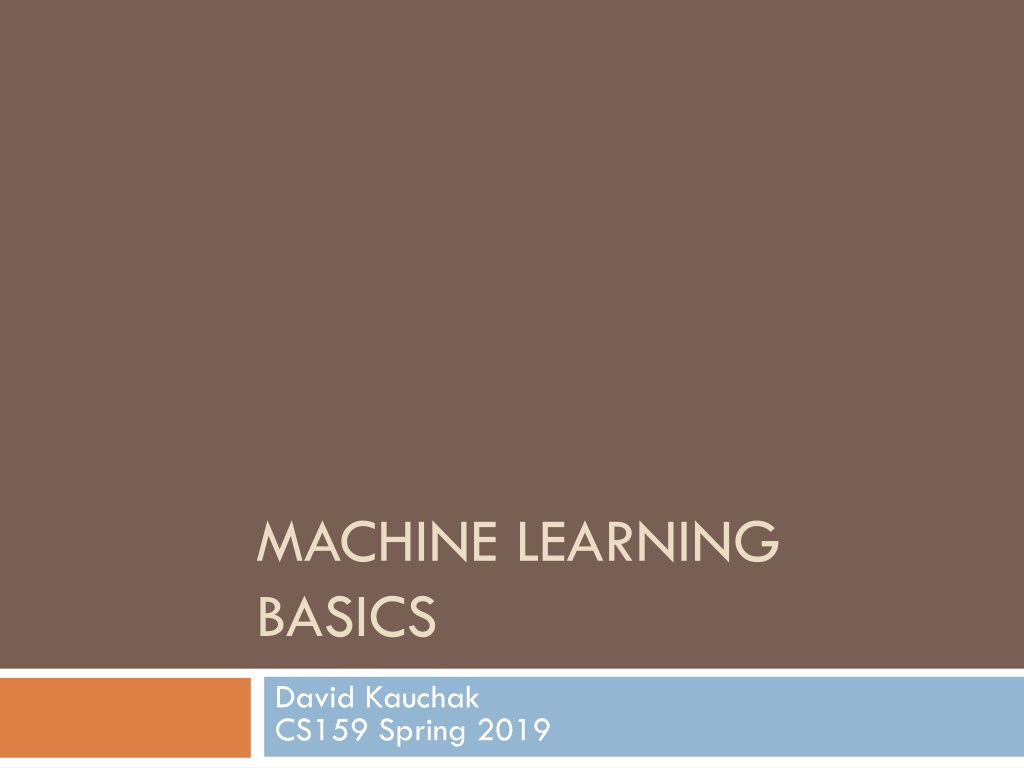
 undefined
undefined








